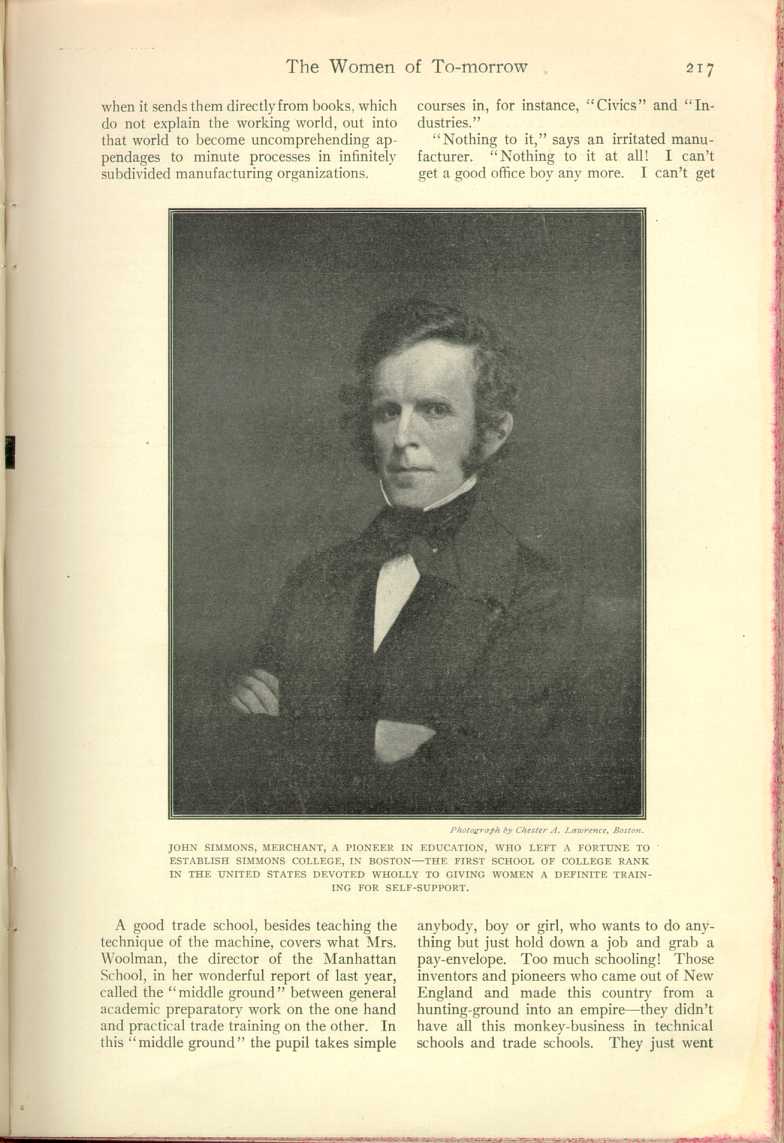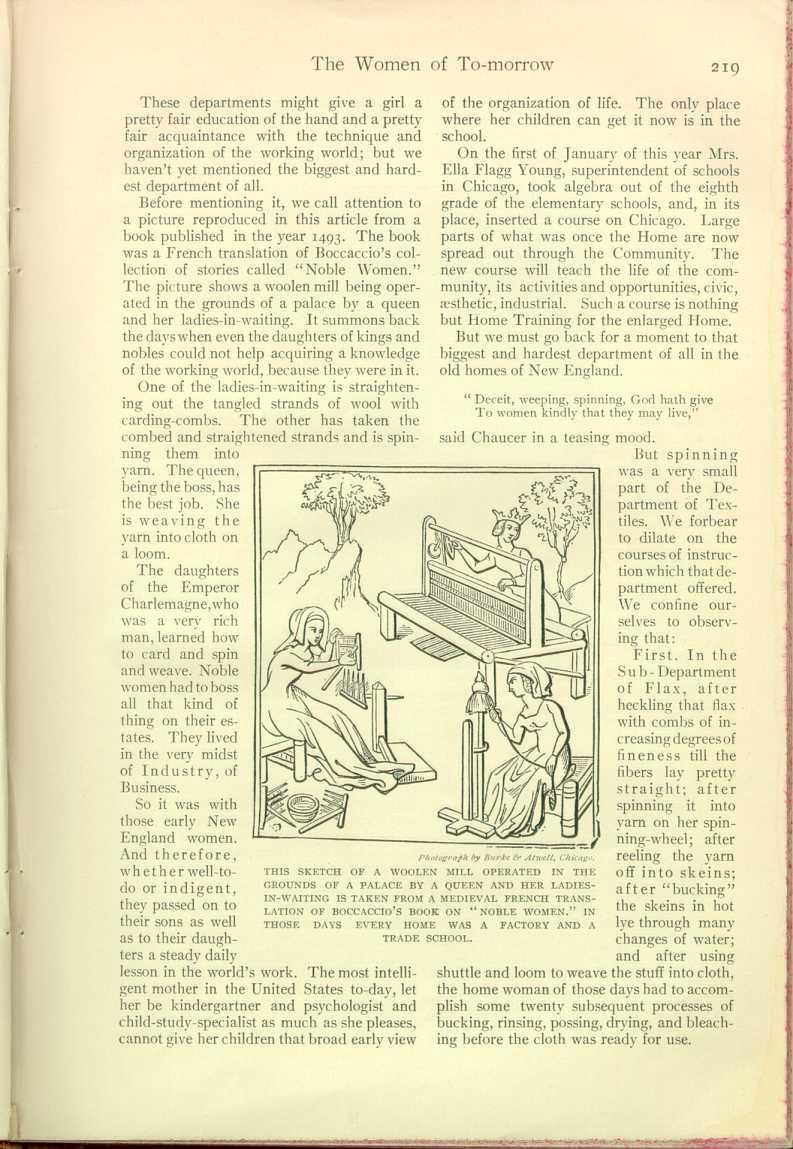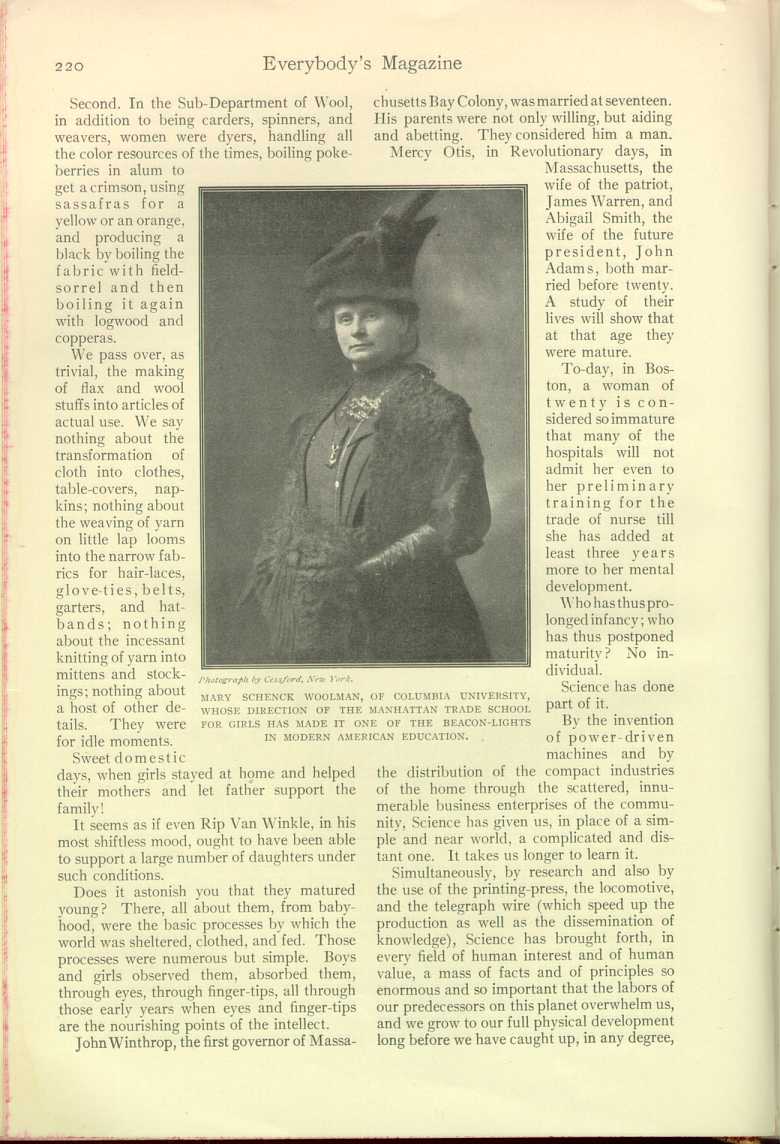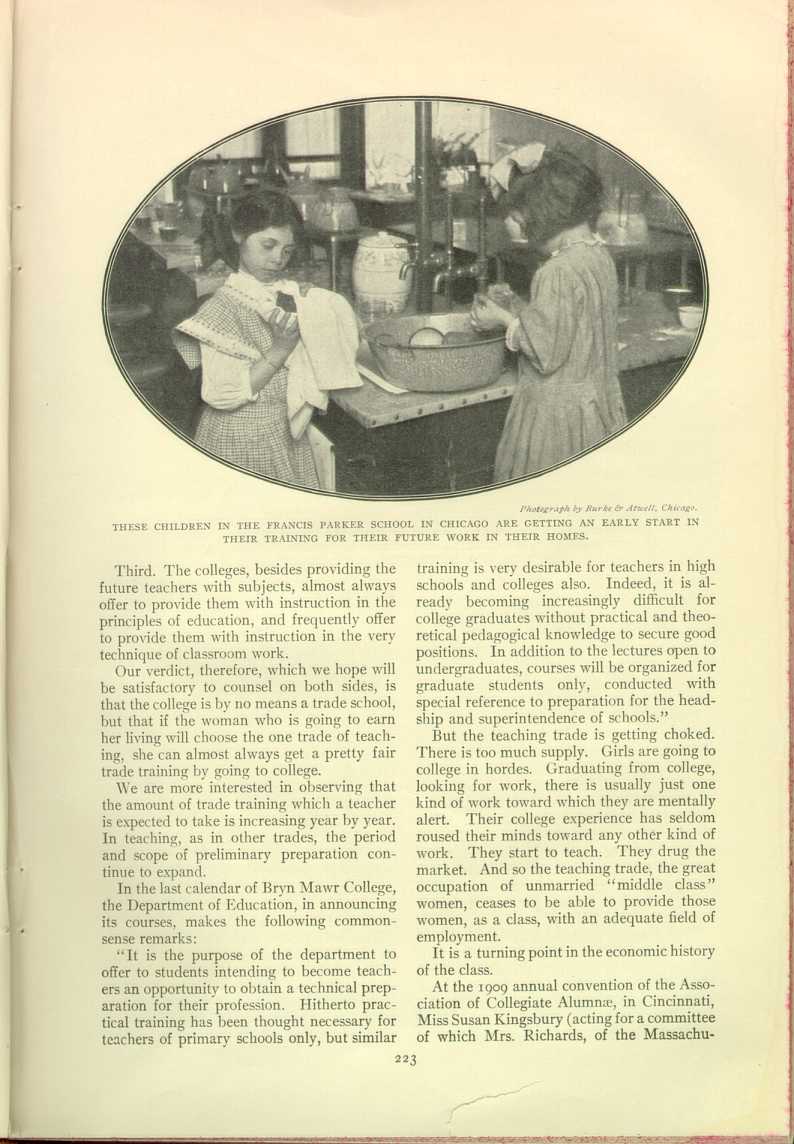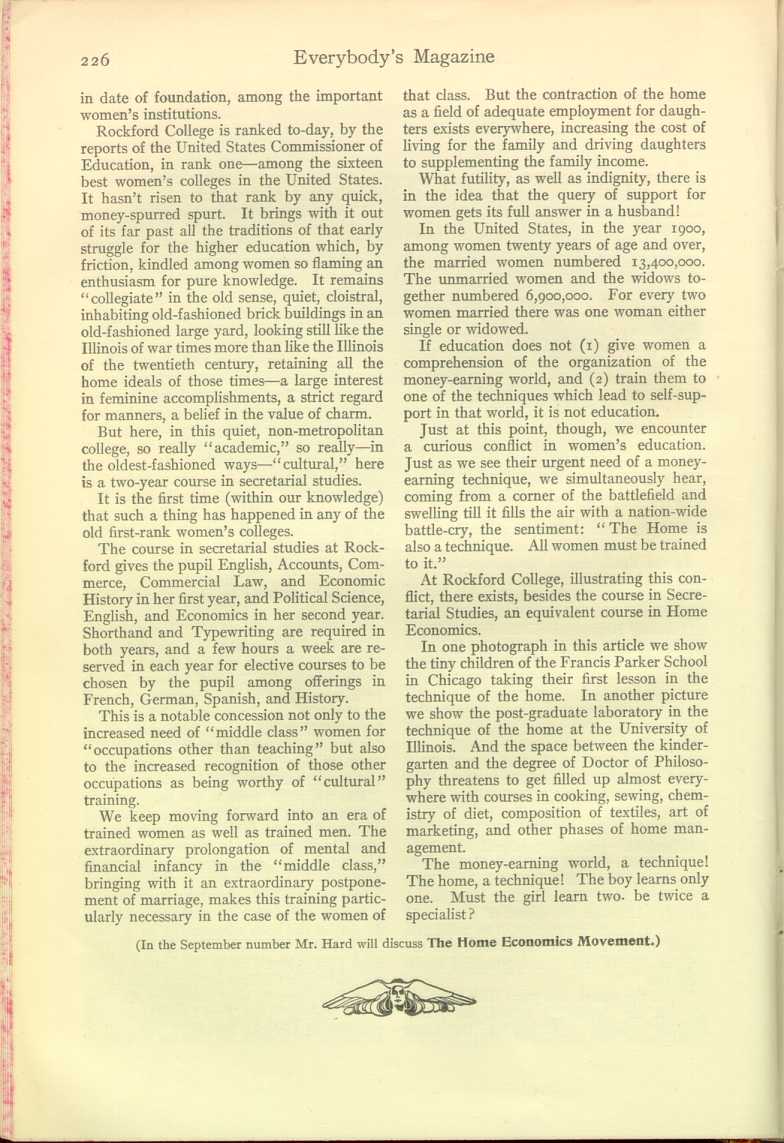| The Women of Tomorrow | ||
THE WOMEN OF TO-MORROW
By WILLIAM HARD
I
EDITOR'S NOTE: It is commonly supposed that only the women of poverty are affected by modern industrial conditions. On the contrary, modern industrial conditions are having their greatest influence among the women who, before marriage, enjoy wide educational opportunities, and who, after marriage, enjoy the blessing of partial leisure. It is among these women that economic developments are producing the profoundest changes in habit of life and in character of mind. Mr Hard, who will be remembered by all readers of the "Woman's Invasion," has spent two years in the diligent investigation of this subject, and has acquired an authoritative knowledge of it.
EVERY Jack has his Jill." It is a tender twilight thought, and it more or less settles Jill.
When the Census Man was at work in 1900, however, he went about and counted 2,260,000 American women who were more than twenty-five years old and who were still unmarried.
It is getting worse (or better) with every passing decade, and out of it is emerging a new ideal of education for women, an ideal which seems certain to penetrate the whole educational system of the United States, all the way from the elementary schools to the universities.
The Census Man groups us into age periods. The period from twenty-five to twenty-nine is the most important matrimonially because it is the one in which most of us get pretty well fixed into our life work. Out of every 1,000 women in that period, in the year 1890, the Census Man found 254 who were still unmarried. In 1900, only ten years later, he found 275.
There is not so much processional as recessional about marriage at present. In navigating the stormy waters of life in the realistic pages of the census reports, it is not till we reach the comparatively serene, landlocked years from forty-five to fifty-four that we find ourselves in an age-period in which the number of single women has been reduced to less than ten per cent. of the total. The rebound from this fact hits education hard. As marriage recedes, and as the period of gainful work before marriage lengthens, the need of real technical preparation for that gainful work becomes steadily more urgent, and the United States moves steadily onward into an era of trained women as well as trained men.
In Boston, at that big new college called Simmons—the first of its kind in the United States—a regular four-year college of which the aim is to send out every graduate technically trained to earn her living in a certain specific occupation, there were enrolled last year, besides some five hundred undergraduate women, some eighty other women who had already earned their bachelor's degrees at other colleges, such as Bryn Mawr, Wellesley, Smith, Vassar, Radcliffe, Leland Stanford, and the University of Montana.
These eighty women, after eight years in elementary schools, four years in high school, and four years in college, were taking one year more in technical school in order to be—what? Not doctors or lawyers or architects. Not anything in the "learned" professions. But to be "social workers" in settlements or for charity societies, to be librarians, to be stenographers and secretaries.
The Bachelor of Arts from Vassar who is going to be a stenographer, and who is taking her year of graduate study at Simmons, will go to work at the end of the year and then, six months later, if she has made good, will get from Simmons the degree of Bachelor of Science. At that point in her life she will have two degrees and seventeen years of schooling behind her. A big background. But we are beginning to do some training for almost everything.
Did you ever see a school of salesmanship for department-store women employees? You can see one at the Women's Educational and Industrial Union in Boston. Under the guidance of Mrs. Lucinda W. Prince, the big department stores of Boston have come to think enough of this school to send girls to it every morning and to pay them full wages while they take a three months' course.
If you will attend any of the classes, in arithmetic, in textiles, in hygiene, in color and design, in demonstration sales, in business forms, you will get not only a new view of the art of selling goods over the counter but a new vision of a big principle in education.
In the class on color, for instance, you will at first be puzzled by the vivid interest taken by the pupils in the theory of it. You have never before observed in any classroom so intimate a concern about rainbows, prisms, spectra, and the scientific sources of æsthetic effects. Your mind runs back to your college days and returns almost alarmed to this unacademic display of genuine, spontaneous, unanimous enthusiasm toward a classroom study of a theoretical subject. At last the reason for it works into your mind. These girls are engaged in the practice of color every afternoon, over hats, ribbons, waists, gloves, costumes. When you begin once to study a subject which reaches practice in your life, you cannot stop with practice. A law of your mind carries you on to the philosophy of it.
Right there you see the reason why trade training, broadly contrived, broadens not only technique but soul, trains not only to earn but to live. "Refined selling," some of the girls call the salesmanship which they learn in Mrs. Prince's class. They have perceived, to some extent, the relation between the arts and sciences on the one hand and their daily work on the other.
To a much greater extent has this relation been perceived by the young woman who has taken the full four-year course in, say, "Secretarial Studies" in Simmons and who, throughout her English, her German, her French, her Sociology, and her History, as well as throughout her Typewriting, her Shorthand, and her Commercial Law, has necessarily kept in mind, irradiating every subject, the light it may throw on the specific work she is to do.
"Ah! There, precisely, is the danger. Every Jack should have his Jill; but if every Jill has her job, why, there again the wedding day goes receding some more into the future. Let them stop all this foolishness and get married, as their grandparents did!"
Poor Jack! Poor Jill! They get lectured at all the time about the postponement of marriage, and they can no more control it than they can control the size of the city of New York. Theoretically, everybody on Manhattan Island could get up and go away and leave the island vacant. Actually, it can't and won't be done. Theoretically, we should all of us get married young. We fall in love young enough. But, actually, we can't get married young, and don't. The reasons are given later. Meanwhile, just notice, and just ponder, the following facts.
It was in the United States as a whole that the Census Man found 275 out of every 1,000 women in the twenty-five-to-twenty-nine age—period unmarried. But the United States consists of developed and undeveloped regions. The cities are the high points of development. Look at the cities:
In Chicago, out of every 1,000 women in the age period from twenty-five to twenty-nine, there were 314 who were unmarried. In Denver there were 331. In Manhattan and the Bronx there were 356. In Minneapolis there were 369. In Philadelphia there were 387.
Southern New England, however, is the most industrially developed part of the United States, the part in which social conditions like those of the older countries of the world are most nearly reached.
In Fall River, out of every 1,000 women in the twenty-five-to-twenty-nine period, the unmarried were 391. In New Haven they were 393. In Boston they were 452.
In view of such facts, how can anybody object to the steps which have been taken recently toward giving the women in the manufacturing trades, as well as the women in the commercial trades, some little preparation for the work in which they are likely to spend so many years?
In the Manhattan Trade School for Girls, in the last eighteen months of record, the enrollment was 1,169. More and more the girls in this school are willing to stay in it for a full year. They have finished at least five grades of the public school, and they are now learning to be milliners, to be dressmakers, to be operators of electric-power machines, to be workers in paste and glue in such occupations as candle-shade-making, to be workers with brush and pencil in furnishing the manufacturing trades with designs.
It is not only a matter of learning to do one particular thing in one particular department in one particular trade. That they could learn in a factory. It is a matter of getting some understanding of a whole trade, or getting some kind of a view of how the world is run. Nobody wants to make people into machines. The object of a good trade school is precisely the reverse. It is the common school which makes people into machines,
A good trade school, besides teaching the technique of the machine, covers what Mrs. Woolman, the director of the Manhattan School, in her wonderful report of last year called the "middle ground" between general academic preparatory work on the one hand and practical trade training on the other. In this "middle ground" the pupil takes simple courses in, for instance, "Civics" and "Industries."
"Nothing to it," says an irritated manufacturer. "Nothing to it at all! I can't get a good office boy any more. I can't get anybody, boy or girl, who wants to do anything but just hold down a job and grab a pay-envelope. Too much schooling! Those inventors and pioneers who came out of New England and made this country from a hunting-ground into an empire—they didn't have all this monkey-business in technical schools and trade schools. They just went
My dear sir, those early New Englanders were in trade schools from the time they began to crawl on the floor among their mothers' looms and spinning-wheels. There was hardly a home in early New England that didn't give a large number of technical courses in which men and women were always teaching by doing, and the boys and girls were always learning by imitating.
The facts about this are so simple and so familiar that we don't stop to think of their meaning. When in the spring the wood-ashes from the winter fires were poured into the lye-barrel, and water was poured in with them, and the lye began to trickle out from the bottom of the barrel, and the winter's savings of grease were brought out, and the grease and the lye were boiled together in the big kettle, and mother had finished making the family's supply of soap for another year, the children had taken not only a little lesson in industriousness, by helping to make the soap, but a little lesson in industry, too, by observing the technique and organization of the soap business from start to finish. A boy from that family, even if he never learned to read or write, might some day have some ideas about soap.
The curriculum of an old New England home, so far as presided over by the wife, may be incompletely suggested as follows:
(N. B. The reader will note the inappropriateness of congratulating the daughters of that home on their not wanting a job. They had it.)
1. A course in Gardening.
"In March and in April, from morning to night,
In sowing and setting good housewives delight."2. A course in Medicinal Herbs. Borage, fennel, wild tansy, wormwood, etc. Methods of distillation. Aqua composita, barberry conserve, electuaries, salves, and ointments. A most important course for every housewife.
"A speedy and a sovereign remedy,
The bitter wormwood, sage and marigold."—FLETCHER: "The Faithful Shepherdess."3. A course in Pickling.
In this course pretty nearly everything will be pickled, down to nasturtium-buds and radish-pods.
VEGETABLES DEPARTMENT.
- 1. A course in Salting Meat in the "powdering" tub.
- 2. A course in Smoking Hams and Bacons.
- 3. A course in Pickling Pig's feet and Ears.
- 4. A course in Headcheese and Sausages.
PACKING-HOUSE DEPARTMENT.
1. A course in Beer. The making of wort out of barley. The making of barm out of hops. The fermenting of the two together in barrels.
(This course is not so much given now in New England, but it is an immemorial heritage of the female sex. Gervayse Markham, in his standard book, "Instructions to a Good Housewife," says about beer: "It is the work and care of woman, for it is a house-work. The man ought only to bring in the grain.")
- 2. A course in Light Drinks, such as Elderberry Wine.
LIQUOR DEPARTMENT.
- 1. A course in Making Butter.
- 2. A course in Making Cheese, Curdling, breaking curds in basket, shaping in cheese press, turning and rubbing cheese on cheese ladder.
CREAMERY DEPARTMENT.
- 1. A course in Soapmaking.
- 2. A course in Making Brooms out of Guinea-wheat Straw.
- 3. A course in Starch making.
- 4. A course in Cleaning.
(This last course is very simple. Having manufactured the things to wash and sweep with, the mere washing and sweeping won't take long.)
CLEANING DEPARTMENT.
- 1. A course in Preserving—everything that can't be pickled.
FRUIT DEPARTMENT.
- 1. A course in Mush and forty kinds of Bread—Rhineinjun (sometimes called Rye and Indian), bun, bannock, jannock, rusk, etc., etc.
BREAKFAST FOOD DEPARTMENT.
- 1. A course in Dips. The melting of tallow
or bayberries. The twisting of wicks. The
attaching of wicks to rods. The dipping
of them into the melted mass in the kettle.
Patience in keeping on dipping them.
(Pupils taking this course are required to report each morning at five o'clock.) - 2. A course in Wax Candles. The use of molds.
LIGHTING DEPARTMENT.
These departments might give a girl a pretty fair education of the hand and a pretty fair acquaintance with the technique and organization of the working world; but we haven't yet mentioned the biggest and hardest department of all.
Before mentioning it, we call attention to a picture reproduced in this article from a book published in the year 1493. The book was a French translation of Boccaccio's collection of stories called "Noble Women." The picture shows a woolen mill being operated in the grounds of a palace by a queen and her ladies-in-waiting. It summons back the days when even the daughters of kings and nobles could not help acquiring a knowledge of the working world, because they were in it.
One of the ladies-in-waiting is straightening out the tangled strands of wool with carding-combs. The other has taken the combed and straightened strands and is spinning them into yarn. The queen, being the boss, has the best job. She is weaving the yarn into cloth on a loom.
The daughters of the Emperor Charlemagne, who was a very rich man, learned how to card and spin and weave. Noble women had to boss all that kind of thing on their estates. They lived in the very midst of Industry, of Business.
So it was with those early New England women. And therefore, whether well-to-do or indigent, they passed on to their sons as well as to their daughters a steady daily lesson in the world's work. The most intelligent mother in the United States to-day, let her be kindergartner and psychologist and child-study-specialist as much as she pleases, cannot give her children that broad early view of the organization of life. The only place where her children can get it now is in the school.
On the first of January of this year Mrs. Ella Flagg Young, superintendent of schools in Chicago, took algebra out of the eighth grade of the elementary schools, and, in its place, inserted a course on Chicago. Large parts of what was once the Home are now spread out through the Community. The new course will teach the life of the community, its activities and opportunities, civic, æsthetic, industrial. Such a course is nothing but Home Training for the enlarged Home.
But we must go back for a moment to that
biggest and hardest department of all in the
old homes of New England.
To women kindly that they may live,"
said Chaucer in a teasing mood.
But spinning was a very small part of the Department of Textiles. We forbear to dilate on the courses of instruction which that department offered. We confine ourselves to observing that:
First. In the Sub-Department of Flax, after heckling that flax with combs of increasing degrees of fineness till the fibers lay pretty straight; after spinning it into yarn on her spinning-wheel; after reeling the yarn off into skeins; after "bucking" the skeins in hot lye through many changes of water; and after using shuttle and loom to weave the stuff into cloth, the home woman of those days had to accomplish some twenty subsequent processes of bucking, rinsing, possing, drying, and bleaching before the cloth was ready for use.
Second. In the Sub-Department of Wool, in addition to being carders, spinners, and weavers, women were dyers, handling all the color resources of the times, boiling poke-berries in alum to get a crimson, using sassafras for a yellow or an orange, and producing a black by boiling the fabric with field-sorrel and then boiling it again with logwood and copperas.
We pass over, as trivial, the making of flax and wool stuffs into articles of actual use. We say nothing about the transformation of cloth into clothes, table-covers, napkins; nothing about the weaving of yarn on little lap looms into the narrow fabrics for hair-laces, glove-ties, belts, garters, and hat-bands; nothing about the incessant knitting of yarn into mittens and stockings; nothing about a host of other details. They were for idle moments.
Sweet domestic days, when girls stayed at home and helped their mothers and let father support the family!
It seems as if even Rip Van Winkle, in his most shiftless mood, ought to have been able to support a large number of daughters under such conditions.
Does it astonish you that they matured young? There, all about them, from babyhood, were the basic processes by which the world was sheltered, clothed, and fed. Those processes were numerous but simple. Boys and girls observed them, absorbed them, through eyes, through finger-tips, all through those early years when eyes and finger-tips are the nourishing points of the intellect.
John Winthrop, the first governor of Massachusetts Bay Colony, was married at seventeen. His parents were not only willing, but aiding and abetting. They considered him a man.
Mercy Otis, in Revolutionary days, in Massachusetts, the wife of the patriot, James Warren, and Abigail Smith, the wife of the future president, John Adams, both married before twenty. A study of their lives will show that at that age they were mature.
To-day, in Boston, a woman of twenty is considered so immature that many of the hospitals will not admit her even to her preliminary training for the trade of nurse till she has added at least three years more to her mental development.
Who has thus prolonged infancy; who has thus postponed maturity? No individual.
Science has done part of it.
By the invention of power-driven machines and by the distribution of the compact industries of the home through the scattered, innumerable business enterprises of the community, Science has given us, in place of a simple and near world, a complicated and distant one. It takes us longer to learn it.
Simultaneously, by research and also by the use of the printing-press, the locomotive, and the telegraph wire (which speed up the production as well as the dissemination of knowledge), Science has brought forth, in every field of human interest and of human value, a mass of facts and of principles so enormous and so important that the labors of our predecessors on this planet overwhelm us, and we grow to our full physical development long before we have caught up, in any degree,
With this postponement of personal maturity, there is an even greater postponement of what might be called "technical" maturity. The real mastery of a real technique takes longer and longer. The teacher must not only go to college but must do graduate work. The young doctor, after he finishes college and medical school, is found as an interne in hospitals, as an assistant to specialists, as a traveler through European lecture-rooms. The young engineer, the young architect, the young specialist of every sort, finds his period of preparation steadily extending before him.
What is left undone by Science in keeping us immature is finally accomplished by System.
The world is getting organized. Except in some of the professions (and often even in them) we most of us start in on our life work at some small subdivided job in a large organization of people. The work of the organization is so systematized as to concentrate responsibility and remuneration toward the top. In time, from job to job, up an ascent which grows longer as the organization grows bigger, we achieve responsibility. Till we do, we discharge minor duties for minimum pay.
This is just as true of the boy from a "middle class" family as it is of the boy from a "working class" family. There follows, however, a most important difference between them. The "middle class" boy will have to work longer and go farther than the "working class" boy in order to rise to the financial standards of his class. In this respect the "working class" boy will be a man, ready for marriage, long before his "middle class" fellow-worker.
It is among "middle class" boys, then, that
the period of infancy is most prolonged.
They get a good deal of schooling. The
stores of human knowledge are put in their
hands, to some extent, and, to some extent,
they catch up with the experience of the race.
This takes a longer and longer effort, particularly
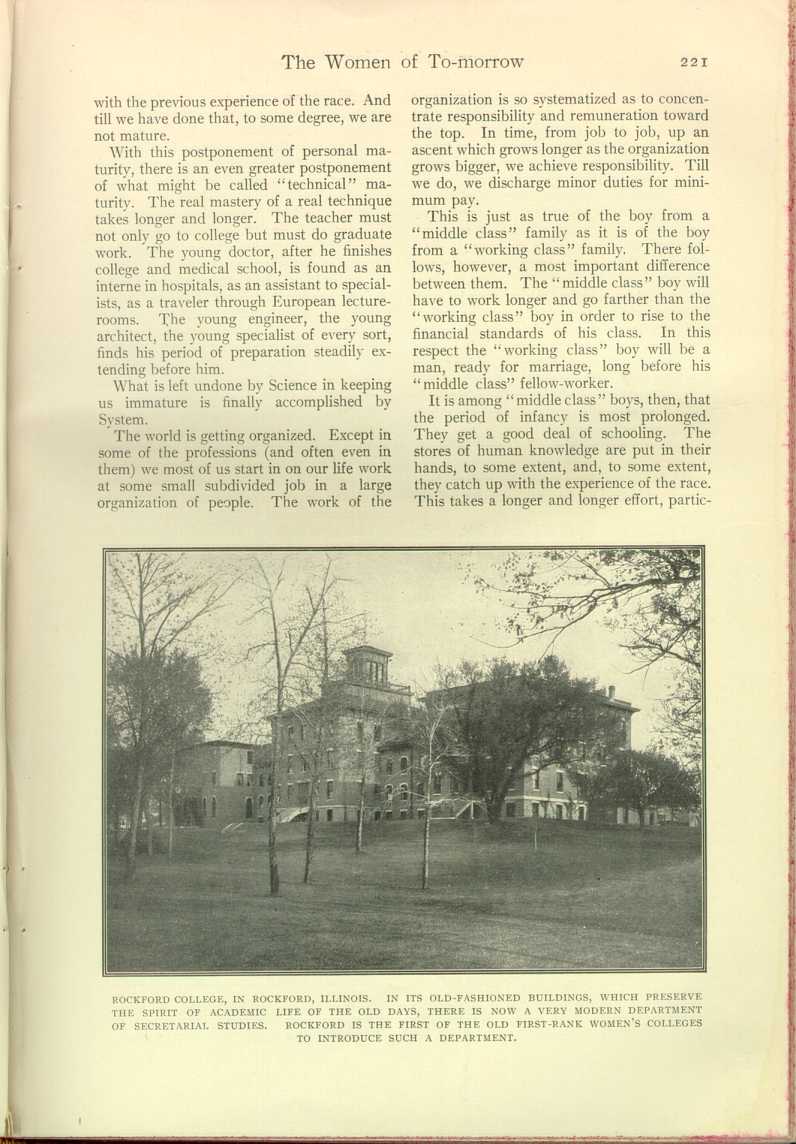
ROCKFORD COLLEGE, IN ROCKFORD, ILLINOIS. IN ITS OLD-FASHIONED
BUILDINGS, WHICH PRESERVE THE SPIRIT OF ACADEMIC LIFE OF THE OLD DAYS, THERE
IS NOW A VERY MODERN DEPARTMENT OF SECRETARIAL STUDIES. ROCKFORD IS THE
FIRST OF THE OLD FIRST-RANK WOMEN'S COLLEGES TO INTRODUCE SUCH A
DEPARTMENT.
[Description:
Photograph of Rockford College.
]
They say that college girls marry late. It is true enough. But it isn't properly stated.
The girls in the kind of family which college girls come from marry late.
It can be definitively established by statistics here considerately omitted that the age of marriage of college girls is no later than the age of marriage of their non-college sisters and acquaintances.
College is not a cause. It is a symptom.
Out of the prolongation of infancy in the "middle class" has come the conquest by women of the intellectual freedom of the world.
It was by no vagary of chance that the demand of women for the higher education came simultaneously with the change from the old industrial home to the new, more purely domestic home. (It may be a higher, nobler type of home. We are not here discussing that point.)
As the home ceased to provide its daughters with adequate education and with adequate employment, what was their situation? In the "working class" it was simply this: That they went into factories and that their sweethearts married them somewhat later than had previously been the case, because their share as wives in the support of the family was increasingly smaller. But the "working class" man soon reaches his maximum earning capacity in his craft and stays there. His financial infancy is short, compared with that of the "middle class" man. He therefore marries younger.
In the "middle class," however, Science and System began to lengthen the mental and financial infancy of the men to such an extent that the "old maid" of twenty-three became common. What were the girls in the "middle class" to do while the boys were growing up to be men, in mind and in money?
The father of Frederick the Great used to go about his realm with a stick, and when he saw a woman in the street he would shake the stick at her and say "Go back into the house. An honest woman keeps indoors."
Probably quite sensible. When she went indoors, she went in to a job. The "middle class" daughter of to-day, if her mother is living and housekeeping, goes indoors into a vacuum.
Out of that vacuum came the explosion which created the first woman's colleges.
There was plenty of sentiment in the explosion. That was the splendid, blinding part of it. That was the part of it which even to-day makes us veil our eves before the nobility of such women as Emma Willard and Mary Lyon. They made Troy Female Seminary in the twenties and Mount Holyoke in the thirties in the image of the aspirations, as well as in the image of the needs, of the women of the times.
But the needs were there, the need to be something, the need to do something, self-respecting, self supporting. The existence of these needs was clearly revealed in the fact that from the early women's colleges and from the early coeducational universities there at once issued a large supply of teachers.
This goes back to the fountainhead of the higher education of women in this country. Emma Willard, even before she founded Troy Female Seminary, back in the days when she was running her school in Middlebury, Connecticut, was training young women to teach, and was acquiring her claim (which she herself subsequently urged) to being regarded as the organizer of the first normal school in the United States.
From that time to this most college women have taught school before getting married. The higher education of women has been, in economic effect, a trade school for training women for the trade of teacher.
But isn't it the purpose of the colleges to avoid training their pupils for specific occupations? Isn't it their purpose to give their pupils discipline and culture, pure and broad, unaffected by commercial intention? Isn't that what colleges are, and ought to be, for?
On the shore of this vast and violent controversy we discreetly pause and stealthily sidle off, taking note of just three reefs of solid fact which unsubmergably jut out above the surface of the raging waters.
First. The colleges instruct their pupils in the subjects which those pupils subsequently teach.
Second. The pupils specialize in the subjects which they are going to teach.
Third. The colleges, besides providing the future teachers with subjects, almost always offer to provide them with instruction in the principles of education, and frequently offer to provide them with instruction in the very technique of classroom work.
Our verdict, therefore, which we hope will be satisfactory to counsel on both sides, is that the college is by no means a trade school, but that if the woman who is going to earn her living will choose the one trade of teaching, she can almost always get a pretty fair trade training by going to college.
We are more interested in observing that the amount of trade training which a teacher is expected to take is increasing year by year. In teaching, as in other trades, the period and scope of preliminary preparation continue to expand.
In the last calendar of Bryn Mawr College, the Department of Education, in announcing its courses, makes the following common-sense remarks:
"It is the purpose of the department to offer to students intending to become teachers an opportunity to obtain a technical preparation for their profession. Hitherto practical training has been thought necessary for teachers of primary schools only, but similar training is very desirable for teachers in high schools and colleges also. Indeed, it is already becoming increasingly difficult for college graduates without practical and theoretical pedagogical knowledge to secure good positions. In addition to the lectures open to undergraduates, courses will be organized for graduate students only, conducted with special reference to preparation for the headship and superintendence of schools."
But the teaching trade is getting choked. There is too much supply. Girls are going to college in hordes. Graduating from college, looking for work, there is usually just one kind of work toward which they are mentally alert. Their college experience has seldom roused their minds toward any other kind of work. They start to teach. They drug the market. And so the teaching trade, the great occupation of unmarried "middle class" women, ceases to be able to provide those women, as a class, with an adequate field of employment.
It is a turning point in the economic history of the class.
At the 1909 annual convention of the Association of Collegiate Alumnæ, in Cincinnati, Miss Susan Kingsbury (acting for a committee of which Mrs. Richards, of the Massachusetts
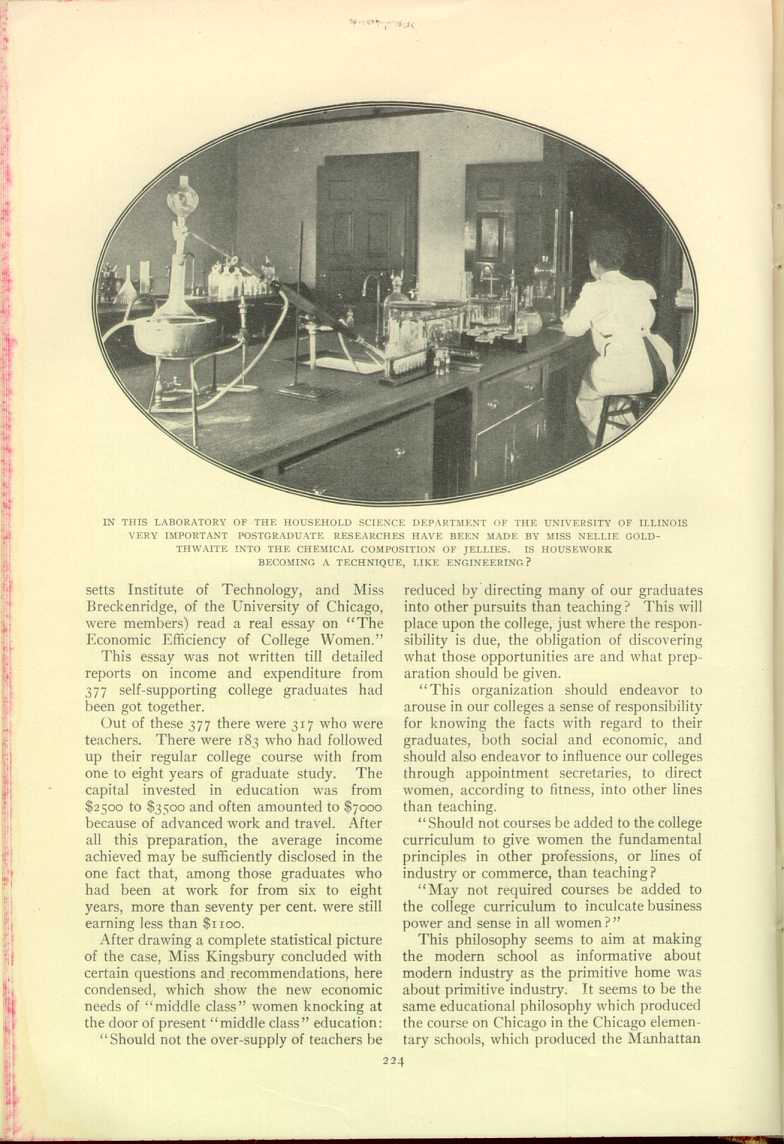
IN THIS LABORATORY OF THE HOUSEHOLD SCIENCE DEPARTMENT OF THE UNIVERSITY OF ILLINOIS VERY IMPORTANT POSTGRADUATE RESEARCHES HAVE BEEN MADE BY MISS NELLIE GOLDTHWAITE INTO THE CHEMICAL COMPOSITION OF JELLIES. IS HOUSEWORK BECOMING A TECHNIQUE, LIKE ENGINEERING?
[Description: Photograph of a household science laboratory at the University of Illinois. ]This essay was not written till detailed reports on income and expenditure from 377 self-supporting college graduates had been got together.
Out of these 377 there were 317 who were teachers. There were 183 who had followed up their regular college course with from one to eight years of graduate study. The capital invested in education was from $2500 to $3500 and often amounted to $7000 because of advanced work and travel. After all this preparation, the average income achieved may be sufficiently disclosed in the one fact that, among those graduates who had been at work for from six to eight years, more than seventy per cent. were still earning less than $1100.
After drawing a complete statistical picture of the case, Miss Kingsbury concluded with certain questions and recommendations, here condensed, which show the new economic needs of "middle class" women knocking at the door of present "middle class" education:
"Should not the over-supply of teachers be reduced by directing many of our graduates into other pursuits than teaching? This will place upon the college, just where the responsibility is due, the obligation of discovering what those opportunities are and what preparation should be given.
"This organization should endeavor to arouse in our colleges a sense of responsibility for knowing the facts with regard to their graduates, both social and economic, and should also endeavor to influence our colleges through appointment secretaries, to direct women, according to fitness, into other lines than teaching.
"Should not courses be added to the college curriculum to give women the fundamental principles in other professions, or lines of industry or commerce, than teaching?
"May not required courses be added to the college curriculum to inculcate business power and sense in all women?"
This philosophy seems to aim at making the modern school as informative about modern industry as the primitive home was about primitive industry. It seems to be the same educational philosophy which produced the course on Chicago in the Chicago elementary schools, which produced the Manhattan
At that Women's Educational and Industrial Union, at 264 Boylston Street, you may see the evolution toward the age of trained women proceeding at all levels of educational equipment.
There, before you, at one level, are the Trade School Shops—a shop in hand-work and a shop in millinery. The pupils are graduates of the Boston Trade School for Girls. They have had one year of training. They are now taking another.
Florence Marshall made the Boston Trade School, with a committee of women to help her. It has now been taken over by the public authorities and merged into the public-school system. What looked like a private fad has become a public function. The training of women for self-support has been recognized as a duty of the state.
The Trade School Shops at the Women's Educational and Industrial Union were started for the express purpose of supplementing the work of the Boston Trade School for Girls. One year was not enough.
In the Trade School the prospective milliner had spent four months on plain sewing, four months on summer hats, four months on winter hats. She had also taken short courses in Personal Hygiene, Business Forms, Spelling, Business English, Color Design, Textiles, Industrial Conditions. These latter courses were not, strictly speaking, "technical." They were "vocational." They were in the "middle ground" between general and technical training. They went beyond the general training of the elementary schools and furnished the girl with the background of her future vocation. But she often needed a little more of the foreground, a little more of actual trade technique.
Thus does her education divide itself up into periods:—general, vocational, technical.
The Trade School Shops are designed to give the girl her final technical finish. They are really more like a factory than like a school. Although the object of them is to convey a broad instruction, the pupil gets wages, the stuff she makes is sold, and the organization is that of a commercial establishment.
So, at the end of two years from the time she left the elementary school, the young milliner is ready to go out into the world organization. She is better fitted for her world than many a college girl is for hers.
On a different level of educational equipment from the Trade School Shops stands the School of Salesmanship. It gets many high school girls and even, occasionally, a girl who has been to college.
Finally, there is the Appointment Bureau, for college girls in particular.
This Appointment Bureau is the most extraordinary employment agency ever organized. Its object is not merely to introduce existing clients to existing jobs (which is the proper normal object of employment agencies), but to make forays into the wild region of "occupations other than teaching," and find jobs, and then find girls to fit those jobs. In other words, it is a kind of "Company of Adventurers Trading into Hudson's Bay" for the purpose of exploring, surveying, developing, and settling the region of "occupations other than teaching" on behalf of college women.
It is managed by Miss Laura Drake Gill, President of the National Association of Collegiate Alumnæ and former Dean of Barnard College. She is assisted by an Advisory Council of representatives of near-by colleges—Radcliffe, Wellesley, Simmons, Mount Holyoke, Smith, and Brown.
There is no more important work being done for women to-day.
In connection with it, the Women's Educational and Industrial Union has just issued a handbook of three hundred pages, entitled "Vocations for the Trained Woman." It is an immense map of the occupational world for "middle class" women, in which every bay and headland, every lake and hill, is drawn to scale, from Poultry Farming to Department Store Buying, from Lunch-Room Management to State Child-Saving.
The responses made to this movement by certain educational institutions (including particularly Simmons College) will be observed in a future article. Just one response, from an unexpected quarter, must be noticed here.
In a small Illinois city there is a woman's college, founded as a Preparatory School in the forties and soon advanced to be a Seminary, which, with Anna P. Sill for its first head, Jane Addams for its best-known graduate, and Julia Gulliver for its present president, has come to be a college of standing and of leading. Only Troy Female Seminary and Mount Holyoke Seminary preceded it,
Rockford College is ranked to-day, by the reports of the United States Commissioner of Education, in rank one—among the sixteen best women's colleges in the United States. It hasn't risen to that rank by any quick, money-spurred spurt. It brings with it out of its far past all the traditions of that early struggle for the higher education which, by friction, kindled among women so flaming an enthusiasm for pure knowledge. It remains "collegiate" in the old sense, quiet, cloistral, inhabiting old-fashioned brick buildings in an old-fashioned large yard, looking still like the Illinois of war times more than like the Illinois of the twentieth century, retaining all the home ideals of those times—a large interest in feminine accomplishments, a strict regard for manners, a belief in the value of charm.
But here, in this quiet, non-metropolitan college, so really "academic," so really—in the oldest-fashioned ways—"cultural," here is a two-year course in secretarial studies.
It is the first time (within our knowledge) that such a thing has happened in any of the old first-rank women's colleges.
The course in secretarial studies at Rockford gives the pupil English, Accounts, Commerce, Commercial Law, and Economic History in her first year, and Political Science, English, and Economics in her second year. Shorthand and Typewriting are required in both years, and a few hours a week are reserved in each year for elective courses to be chosen by the pupil among offerings in French, German, Spanish, and History.
This is a notable concession not only to the increased need of "middle class" women for "occupations other than teaching" but also to the increased recognition of those other occupations as being worthy of "cultural" training.
We keep moving forward into an era of trained women as well as trained men. The extraordinary prolongation of mental and financial infancy in the "middle class," bringing with it an extraordinary postponement of marriage, makes this training particularly necessary in the case of the women of that class. But the contraction of the home as a field of adequate employment for daughters exists everywhere, increasing the cost of living for the family and driving daughters to supplementing the family income.
What futility, as well as indignity, there is in the idea that the query of support for women gets its full answer in a husband!
In the United States, in the year 1900, among women twenty years of age and over, the married women numbered 13,400,000. The unmarried women and the widows together numbered 6,900,000. For every two women married there was one woman either single or widowed.
If education does not (1) give women a comprehension of the organization of the money-earning world, and (2) train them to one of the techniques which lead to self-support in that world, it is not education.
Just at this point, though, we encounter a curious conflict in women's education. Just as we see their urgent need of a money-earning technique, we simultaneously hear, coming from a corner of the battlefield and swelling till it fills the air with a nation-wide battle-cry, the sentiment: "The Home is also a technique. All women must be trained to it."
At Rockford College, illustrating this conflict, there exists, besides the course in Secretarial Studies, an equivalent course in Home Economics.
In one photograph in this article we show the tiny children of the Francis Parker School in Chicago taking their first lesson in the technique of the home. In another picture we show the post-graduate laboratory in the technique of the home at the University of Illinois. And the space between the kindergarten and the degree of Doctor of Philosophy threatens to get filled up almost everywhere with courses in cooking, sewing, chemistry of diet, composition of textiles, art of marketing, and other phases of home management.
The money-earning world, a technique! The home, a technique! The boy learns only one. Must the girl learn two, be twice a specialist?
| The Women of Tomorrow | ||
